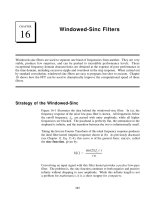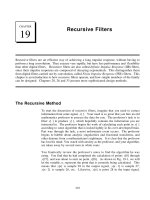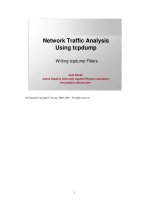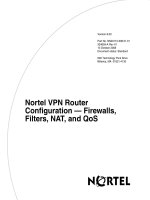Recursive Filters
Bạn đang xem bản rút gọn của tài liệu. Xem và tải ngay bản đầy đủ của tài liệu tại đây (354.39 KB, 14 trang )
319
CHAPTER
19
Recursive Filters
Recursive filters are an efficient way of achieving a long impulse response, without having to
perform a long convolution. They execute very rapidly, but have less performance and flexibility
than other digital filters. Recursive filters are also called Infinite Impulse Response (IIR) filters,
since their impulse responses are composed of decaying exponentials. This distinguishes them
from digital filters carried out by convolution, called Finite Impulse Response (FIR) filters. This
chapter is an introduction to how recursive filters operate, and how simple members of the family
can be designed. Chapters 20, 26 and 33 present more sophisticated design methods.
The Recursive Method
To start the discussion of recursive filters, imagine that you need to extract
information from some signal, . Your need is so great that you hire an oldx[ ]
mathematics professor to process the data for you. The professor's task is to
filter to produce , which hopefully contains the information you arex[ ] y[ ]
interested in. The professor begins his work of calculating each point in y[ ]
according to some algorithm that is locked tightly in his over-developed brain.
Part way through the task, a most unfortunate event occurs. The professor
begins to babble about analytic singularities and fractional transforms, and
other demons from a mathematician's nightmare. It is clear that the professor
has lost his mind. You watch with anxiety as the professor, and your algorithm,
are taken away by several men in white coats.
You frantically review the professor's notes to find the algorithm he was
using. You find that he had completed the calculation of points throughy[0]
, and was about to start on point . As shown in Fig. 19-1, we willy[27] y[28]
let the variable, n, represent the point that is currently being calculated. This
means that is sample 28 in the output signal, is sample 27,y[n] y[n&1]
is sample 26, etc. Likewise, is point 28 in the input signal,y[n&2] x[n]
The Scientist and Engineer's Guide to Digital Signal Processing320
y [n ] ' a
0
x [n ] % a
1
x [n &1] % a
2
x [n &2] % a
3
x [n &3] % þ
y [n ] ' a
0
x [n ] % a
1
x [n &1] % a
2
x [n &2] % a
3
x [n &3] % þ
% b
1
y [n &1] % b
2
y [n &2] % b
3
y [n &3] % þ
EQUATION 19-1
The recursion equation. In this equation, isx[ ]
the input signal, is the output signal, and they[ ]
a's and b's are coefficients.
is point 27, etc. To understand the algorithm being used, we askx[n&1]
ourselves: "What information was available to the professor to calculate ,y[n]
the sample currently being worked on?"
The most obvious source of information is the input signal, that is, the values:
. The professor could have been multiplying each pointx[n], x[n&1], x[n&2], þ
in the input signal by a coefficient, and adding the products together:
You should recognize that this is nothing more than simple convolution, with
the coefficients: , forming the convolution kernel. If this was all thea
0
, a
1
, a
2
, þ
professor was doing, there wouldn't be much need for this story, or this chapter.
However, there is another source of information that the professor had access
to: the previously calculated values of the output signal, held in:
. Using this additional information, the algorithmy[n&1], y[n&2], y[n&3], þ
would be in the form:
In words, each point in the output signal is found by multiplying the values
from the input signal by the "a" coefficients, multiplying the previously
calculated values from the output signal by the "b" coefficients, and adding the
products together. Notice that there isn't a value for , because thisb
0
corresponds to the sample being calculated. Equation 19-1 is called the
recursion equation, and filters that use it are called recursive filters. The
"a" and "b" values that define the filter are called the recursion coefficients.
In actual practice, no more than about a dozen recursion coefficients can be
used or the filter becomes unstable (i.e., the output continually increases or
oscillates). Table 19-1 shows an example recursive filter program.
Recursive filters are useful because they bypass a longer convolution. For
instance, consider what happens when a delta function is passed through a
recursive filter. The output is the filter's impulse response, and will typically
be a sinusoidal oscillation that exponentially decays. Since this impulse
response in infinitely long, recursive filters are often called infinite impulse
response (IIR) filters. In effect, recursive filters convolve the input signal with
a very long filter kernel, although only a few coefficients are involved.
Chapter 19- Recursive Filters 321
Sample number
0 10 20 30
-2
-1
0
1
2
a. The input signal, x[ ]
x[n-3]
x[n-2]
x[n]
x[n-1]
Sample number
0 10 20 30
-2
-1
0
1
2
b. The output signal, y[ ]
y[n-3]
y[n-2]
y[n]
y[n-1]
FIGURE 19-1
Recursive filter notation. The output sample being calculated, , is determined by the values fromy[n]
the input signal, , as well as the previously calculated values in the output
x[n], x[n&1], x[n&2], þ
signal, . These figures are shown for . y[n&1], y[n&2], y[n&3], þ n ' 28
Amplitude
Amplitude
100 'RECURSIVE FILTER
110 '
120 DIM X[499] 'holds the input signal
130 DIM Y[499] 'holds the filtered output signal
140 '
150 GOSUB XXXX 'mythical subroutine to calculate the recursion
160 ' 'coefficients: A0, A1, A2, B1, B2
170 '
180 GOSUB XXXX 'mythical subroutine to load X[ ] with the input data
190 '
200 FOR I% = 2 TO 499
210 Y[I%] = A0*X[I%] + A1*X[I%-1] + A2*X[I%-2] + B1*Y[I%-1] + B2*Y[I%-2]
220 NEXT I%
230 '
240 END
TABLE 19-1
The relationship between the recursion coefficients and the filter's response is
given by a mathematical technique called the z-transform, the topic of
Chapter 33. For example, the z-transform can be used for such tasks as:
converting between the recursion coefficients and the frequency response,
combining cascaded and parallel stages into a single filter, designing recursive
systems that mimic analog filters, etc. Unfortunately, the z-transform is very
mathematical, and more complicated than most DSP users are willing to deal
with. This is the realm of those that specialize in DSP.
There are three ways to find the recursion coefficients without having to
understand the z-transform. First, this chapter provides design equations for
several types of simple recursive filters. Second, Chapter 20 provides a
"cookbook" computer program for designing the more sophisticated Chebyshev
low-pass and high-pass filters. Third, Chapter 26 describes an iterative method
for designing recursive filters with an arbitrary frequency response.
The Scientist and Engineer's Guide to Digital Signal Processing322
Sample number
0 10 20 30 40
-0.5
0.0
0.5
1.0
1.5
Sample number
0 10 20 30 40
-0.5
0.0
0.5
1.0
1.5
Time
0 10 20 30
-0.5
0.0
0.5
1.0
1.5
Time
0 10 20 30 40
-0.5
0.0
0.5
1.0
1.5
R
C
Digital Filter
Analog Filter
Recursive
Filter
a
0
= 0.15
b
1
= 0.85
FIGURE 19-2
Single pole low-pass filter. Digital recursive filters can mimic analog filters composed of resistors and
capacitors. As shown in this example, a single pole low-pass recursive filter smoothes the edge of a step input,
just as an electronic RC filter.
Amplitude
AmplitudeAmplitude
Amplitude
Single Pole Recursive Filters
Figure 19-2 shows an example of what is called a single pole low-pass filter.
This recursive filter uses just two coefficients, and . Fora
0
' 0.15 b
1
' 0.85
this example, the input signal is a step function. As you should expect for a
low-pass filter, the output is a smooth rise to the steady state level. This figure
also shows something that ties into your knowledge of electronics. This low-
pass recursive filter is completely analogous to an electronic low-pass filter
composed of a single resistor and capacitor.
The beauty of the recursive method is in its ability to create a wide variety of
responses by changing only a few parameters. For example, Fig. 19-3 shows
a filter with three coefficients: , and . Asa
0
' 0.93 a
1
' &0.93 b
1
' 0.86
shown by the similar step responses, this digital filter mimics an electronic RC
high-pass filter.
These single pole recursive filters are definitely something you want to keep
in your DSP toolbox. You can use them to process digital signals just as
you would use RC networks to process analog electronic signals. This
includes everything you would expect: DC removal, high-frequency noise
suppression, wave shaping, smoothing, etc. They are easy to program, fast
Chapter 19- Recursive Filters 323
Sample number
0 10 20 30 40
-0.5
0.0
0.5
1.0
1.5
Sample number
0 10 20 30 40
-0.5
0.0
0.5
1.0
1.5
Time
0 10 20 30
-0.5
0.0
0.5
1.0
1.5
Time
0 10 20 30 40
-0.5
0.0
0.5
1.0
1.5
Recursive
Filter
a
0
= 0.93
a
1
= -0.93
R
C
Digital Filter
Analog Filter
b
1
= 0.86
FIGURE 19-3
Single pole high-pass filter. Proper coefficient selection can also make the recursive filter mimic an electronic
RC high-pass filter. These single pole recursive filters can be used in DSP just as you would use RC circuits
in analog electronics.
Amplitude
AmplitudeAmplitude
Amplitude
EQUATION 19-3
Single pole high-pass filter.
a
0
' (1%x )/2
a
1
' &(1%x)/2
b
1
' x
EQUATION 19-2
Single pole low-pass filter. The filter's
response is controlled by the parameter, x,
a value between zero and one.
a
0
' 1&x
b
1
' x
to execute, and produce few surprises. The coefficients are found from these
simple equations:
The characteristics of these filters are controlled by the parameter, x, a
value between zero and one. Physically, x is the amount of decay between
adjacent samples. For instance, x is 0.86 in Fig. 19-3, meaning that the
value of each sample in the output signal is 0.86 the value of the sample
before it. The higher the value of x, the slower the decay. Notice that the









